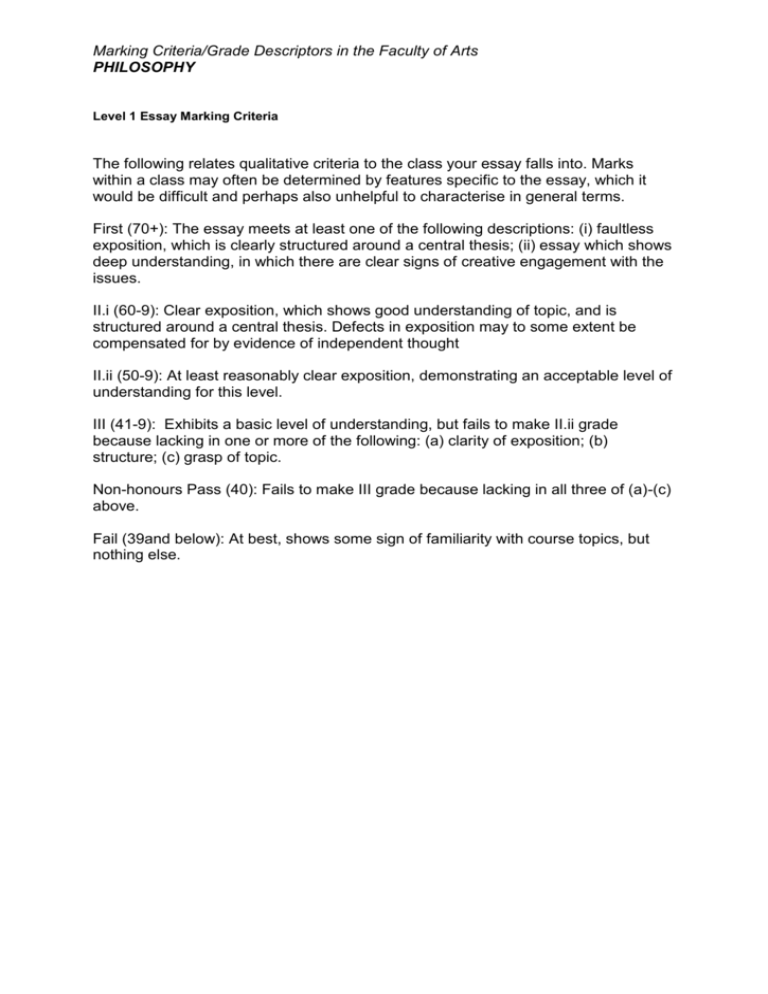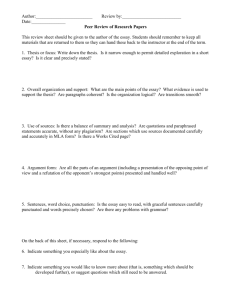SCHOOL OF PHILOSOPHY
advertisement

Marking Criteria/Grade Descriptors in the Faculty of Arts PHILOSOPHY Level 1 Essay Marking Criteria The following relates qualitative criteria to the class your essay falls into. Marks within a class may often be determined by features specific to the essay, which it would be difficult and perhaps also unhelpful to characterise in general terms. First (70+): The essay meets at least one of the following descriptions: (i) faultless exposition, which is clearly structured around a central thesis; (ii) essay which shows deep understanding, in which there are clear signs of creative engagement with the issues. II.i (60-9): Clear exposition, which shows good understanding of topic, and is structured around a central thesis. Defects in exposition may to some extent be compensated for by evidence of independent thought II.ii (50-9): At least reasonably clear exposition, demonstrating an acceptable level of understanding for this level. III (41-9): Exhibits a basic level of understanding, but fails to make II.ii grade because lacking in one or more of the following: (a) clarity of exposition; (b) structure; (c) grasp of topic. Non-honours Pass (40): Fails to make III grade because lacking in all three of (a)-(c) above. Fail (39and below): At best, shows some sign of familiarity with course topics, but nothing else. Marking Criteria/Grade Descriptors in the Faculty of Arts PHILOSOPHY Level 1 Essay Marking Guide For Tutors Criteria The essay is graded from A (best) to E (worst) on each of the following: 1. Argument: There is an easily discernible and coherent structure and a clear conclusion; views are not just reported but criticised; possible replies to those criticisms are considered. 2. Clarity: Points are made concisely and are easy to understand, not vague, convoluted or rambling. 3. Independence: The essay expresses a point of view, and does not just summarize course materials. 4. Knowledge: The essay displays relevant knowledge and comprehension of the issues; problems, positions, objections, etc., are accurately reported, and relevant terms defined. 5. Relevance: The answer is relevant to the question set. First (70+): The essay meets at least one of the following descriptions: (i) faultless exposition, which is clearly structured around a central thesis; (ii) essay which shows deep understanding, in which there are clear signs of creative engagement with the issues. II.i (60-9): Clear exposition, which shows good understanding of topic, and is structured around a central thesis. Defects in exposition may to some extent be compensated for by evidence of independent thought II.ii (50-9): At least reasonably clear exposition, demonstrating an acceptable level of understanding for this level. III (41-9): Exhibits a basic level of understanding, but fails to make II.ii grade because lacking in one or more of the following: (a) clarity of exposition; (b) structure; (c) grasp of topic. Non-honours Pass (40): Fails to make III grade because lacking in all three of (a)-(c) above. Fail (39 and below): At best, shows some sign of familiarity with course topics, but nothing else. Marking Criteria/Grade Descriptors in the Faculty of Arts PHILOSOPHY Upper Level Essay Marking Criteria The following relates qualitative criteria to the class your essay falls into. Marks within a class may often be determined by features specific to the essay, which it would be difficult and perhaps also unhelpful to characterise in general terms. First (70+): The essay meets at least one of the following descriptions: (i) faultless exposition, which is clearly structured around a central thesis, and in which there is at least some evidence of independent thought; (ii) essay which shows deep understanding, in which there are clear signs of creative engagement with the issues. II.i (60-9): Clear exposition, which shows good understanding of topic, is structured around a central thesis, and goes beyond course materials. II.ii (50-9): At least reasonably clear exposition, demonstrating an acceptable level of understanding. Defects in exposition may to some extent be compensated for by evidence of independent thought. III (41-9): Exhibits a least a basic understanding, but fails to make II.ii grade because lacking in one or more of the following: (a) clarity of exposition; (b) structure; (c) grasp of topic. Non-honours Pass (40): Fails to make III grade because lacking in all three of (a)-(c) above. Fail (39 and below): At best, shows some sign of familiarity with course topics, but nothing else. Marking Criteria/Grade Descriptors in the Faculty of Arts PHILOSOPHY Taught MA in Philosophy Taught MA in History and Philosophy of Science Marking and Classification Guide Kinds of programme It will be useful to distinguish between two kinds of taught M.A. programme: (a) conversion courses, typically aimed at students who have had no or little previous formal education in the discipline; (b) advanced courses, typically aimed at those with a good first degree in the discipline. The rules over degree classification and marking criteria for conversion courses are set out in a separate document. What follows applies only to advanced courses. Degree classification and marking scheme Unlike undergraduate honours degrees, M.A. degrees admit only of three classifications: Distinction, Pass and Fail. A candidate is awarded an overall distinction if a mark of 70 or above has been achieved on 80 credits, and no mark is below 50. To obtain an overall pass a candidate must have achieved an average mark over all modules of 50, no mark in 100 credits falling below 40. Examiners may use discretion in borderline cases (e.g. an overall average of 69 and a mark of 70+ on 40 credits). Marking criteria The following qualitative criteria should be applied: Distinction (72+): The essay meets at least one of the following descriptions: (i) essay which shows deep understanding of the topic, in which there is a substantial degree of creative engagement with the issues; (ii) faultless exposition, which is clearly structured around a central thesis, and in which there are clear signs of independent thought. Good pass (64-8): Very clear and accurate exposition, which shows good understanding of topic, is structured around a central thesis, and in which there are signs of independent thought. Average pass (57-63): Reasonably clear and accurate exposition, structured around a central thesis, which shows adequate grasp of topic, and which goes beyond the course materials. Low pass (52-56): Exhibits rather basic, but still acceptable, level of relevant knowledge and understanding. Faults in exposition may to some extent be compensated for by evidence of independent thought. Fail (48 or below): Fails to make low pass grade because significantly lacking in one or more of the following: (a) clarity of exposition; (b) structure; (c) grasp of topic.









